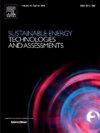Techno-economic evaluation of novel combinations of reverse osmosis with absorption and HDH desalination systems for energy utilization and sustainability
IF 7.1
2区 工程技术
Q1 ENERGY & FUELS
Sustainable Energy Technologies and Assessments
Pub Date : 2025-07-15
DOI:10.1016/j.seta.2025.104451
引用次数: 0
Abstract
Reverse osmosis (RO) is a widely used technology for water desalination nowadays, owing to its high water production. However, it suffers from high consumption of high-grade energy and the generation of large amounts of high-concentration brine, which is harmful to the environment. This study provided an innovative solar-powered hybrid desalination plant that integrates RO, an absorption (AB) desalination-cooling system, and a humidification-dehumidification (HDH) system for mitigating water shortage, optimizing energy utilization, and reducing carbon emissions. The rejected brine from the RO system is treated further by passing it through the AB and HDH desalination systems to produce additional fresh water and treat the rejected brine. In addition, the feed RO brine is passed through the absorber before entering the HDH system, which eliminates a separate heat source to preheat the fluid entering heat the fluid filling the humidifier. In this study, two configurations of hybrid systems were proposed and compared. In the first configuration (RO-AB-HDH), a simultaneous drinking water and cooling effect (from the AB system) can be obtained. In the second configuration, an energy recovery scheme is used between the condenser and evaporator (HR) of the AB to enhance the evaporation rate and the water production rate. Numerical models were developed to simulate and evaluate the performance and economic viability of the proposed systems for various operating conditions. Results showed that the proposed hybrid systems significantly improve the quality and quantity of desalinated water, as well as reduce the cost of freshwater, compared to the stand-alone RO cycle. For instance, the product freshwater salinity obtained by the proposed systems is decreased by 63 %, compared to the RO system for an applied pressure of 70 bar and feed salinity of 50,000 ppm. The first configuration is the most cost-effective at a high salinity of 45,000–50,000 ppm when the system is driven by solar energy with 2.2 $/m3 with an additional free-cooling effect of 17.6 kW at 85 °C. The second configuration is more effective when only a large amount of desalinated fresh water is needed.
新组合的反渗透与吸收和HDH脱盐系统的能源利用和可持续性的技术经济评价
反渗透(RO)技术因其产水量高而成为目前广泛应用的海水淡化技术。但是,它的缺点是高等级能源的消耗和大量高浓度卤水的产生,对环境有害。该研究提供了一种创新的太阳能混合海水淡化装置,该装置集成了RO,吸收(AB)脱盐冷却系统和加湿-除湿(HDH)系统,以缓解水资源短缺,优化能源利用并减少碳排放。RO系统排出的卤水将通过AB和HDH脱盐系统进行进一步处理,以产生额外的淡水并处理排出的卤水。此外,进料RO卤水在进入HDH系统之前通过吸收器,这就省去了一个单独的热源来预热进入加湿器的流体。在本研究中,提出并比较了两种混合系统的配置。在第一种配置(RO-AB-HDH)中,可以同时获得饮用水和冷却效果(来自AB系统)。在第二种配置中,在AB的冷凝器和蒸发器(HR)之间采用能量回收方案,以提高蒸发速率和出水量。开发了数值模型来模拟和评估所提出的系统在各种操作条件下的性能和经济可行性。结果表明,与独立的RO循环相比,所提出的混合系统显著提高了淡化水的质量和数量,并降低了淡水成本。例如,与施加压力为70 bar、进料盐度为50,000 ppm的RO系统相比,该系统获得的产品淡水盐度降低了63%。第一种配置在45000 - 50000 ppm的高盐度环境中最具成本效益,当系统由太阳能驱动时,成本为2.2美元/立方米,在85°C时额外的自然冷却效果为17.6千瓦。当只需要大量脱盐淡水时,第二种配置更有效。
本文章由计算机程序翻译,如有差异,请以英文原文为准。
求助全文
约1分钟内获得全文
求助全文
来源期刊

Sustainable Energy Technologies and Assessments
Energy-Renewable Energy, Sustainability and the Environment
CiteScore
12.70
自引率
12.50%
发文量
1091
期刊介绍:
Encouraging a transition to a sustainable energy future is imperative for our world. Technologies that enable this shift in various sectors like transportation, heating, and power systems are of utmost importance. Sustainable Energy Technologies and Assessments welcomes papers focusing on a range of aspects and levels of technological advancements in energy generation and utilization. The aim is to reduce the negative environmental impact associated with energy production and consumption, spanning from laboratory experiments to real-world applications in the commercial sector.
 求助内容:
求助内容: 应助结果提醒方式:
应助结果提醒方式:


